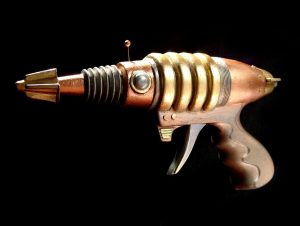
Retro Raygun by Donsolo
Science Fiction from its earliest incarnations has always featured some sort of futuristic weaponry. From H.G. Wells’ martian heat-ray to the most modern charged particle beam of Alastair Reynolds, SF weapons astound, confound and amaze readers. I have always loved the idea of the raygun since I read my father’s pulp space patrol books from when he was a kid. And as with every thing, what is old is new again. Images of SF pulp are everywhere and the classic deathray is in vogue once more.
The question is: How useful or realistic are the ray-guns of yore or the modern revamped directed energy weapons?
In the next few posts I will be examining various kinds of futuristic weaponry that have appeared in SF through the ages; everything from Tesla’s teleforce weapon to “rods from God”. I will attempt to describe the relative advantages and disadvantages of each, report on any real world examples or research and pick a particular, author or television show which presents that particular kind of weapon.
Since there are some many kinds of SF weapons I will be dividing up them into three broad categories:
- Directed Energy Weapons
- Kinetic Weapons
- Death-rays (while these are technically a kind of DEW, they are so cool that they really deserve their own category)
As it turns out, there are more kinds of real-world weapons that are clearly Science Fictional than you would believe. I will be including examples of weaponry that isn’t SF but should be.
If any readers have a particular kind of SF weapon they would like me to discuss, post a comment and I will do my best to write it up.











Will there be a forth section dedicated to "planet buster" future weapons or will you focus only on handgun/portable weapons?
I would dearly like to know whether Peter F. Hamilton's "Hawking M-sink" has any roots in scientific plausibility. Basically it's a mini black hole. Fire it into e.g. a planet and it sinks to the planet's center of gravity, then just expands until it has eaten all the mass within reach. What do you think? Theoretically doable?
Well, theoretically, it could be feasible. That is, if we can assume a technology that allows for the creation of black holes. These objects are born in so violent of circumstances, it is difficult to imagine an actual technology capable of creating them.
The effects would be profound. The BH, assuming that it has only enough momentum to penetrate the crust and not travel completely through the planet, would most likely pong pong back thoroughly the interior until it settled down in the core. On each pass it would deform the crust significantly causing all manner of earthquakes, tsunami, volcanism; your basic hell scape. All life would be extinguished long before the BH devoured the planet.
The real problem with this weapon is Hawking radiation. All black holes emit a type of radiation that slowly decreases its mass. It's generally not noticed because the BH ears more than it loses, but small black holes can lose mass so quickly that a certain point, they explode catastrophically. I don't have the specific masses handy, but I would say that any BH small enough to be used as a weapon would also be small enough to explode.
I will have to do some more research, but that is the basics. Thanks for your question!